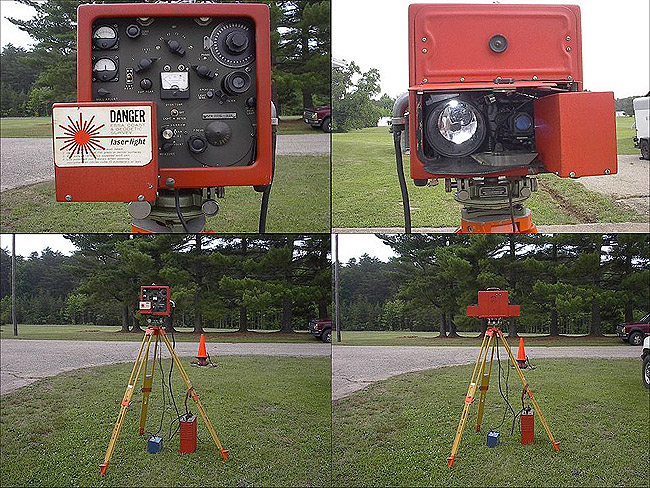 Great Theodolite
Great Theodolite The Bache- Wurdemann Compensating Device
The Bache- Wurdemann Compensating Device Eimbeck Duplex Bars
Eimbeck Duplex Bars Iced Bar B 17
Iced Bar B 17 Steel Tape with Tape Stretcher
Steel Tape with Tape Stretcher Invar Tape
Invar Tape AGA Geodimeter NASM-2A
AGA Geodimeter NASM-2A Tellurometer Model M/RA 1
Tellurometer Model M/RA 1 Laser Signal and Prismatic Mirror Reflecting System
Laser Signal and Prismatic Mirror Reflecting System AGA Geodimeters, Models 4D and 4L
AGA Geodimeters, Models 4D and 4L Big Red
Big Red AGA Geodimeter Model 6
AGA Geodimeter Model 6 Hewlett-Packard Model 3800B Distance Meter
Hewlett-Packard Model 3800B Distance Meter Tellurometer Model MA-100
Tellurometer Model MA-100 Ranger III and Rangemaster III
Ranger III and Rangemaster III Topcon ET-1 Total Station
Topcon ET-1 Total Station Trimble GPS Antenna
Trimble GPS Antenna
Big Red
"Big Red," the nickname for a custom-modified Geodimeter, used a powerful red laser to determine distances. Shown in the photo, Big Red was one of many pieces of equipment that technicians from the Coast and Geodetic Survey modified to increase accuracy and ease-of-use.
Clockwise from top left: Control panel; optics; set up showing separate power packs for Geodimeter and laser; and a side view of the instrument. Photos courtesy of Charlie Glover.
Geodimeters work by sending a light signal of known wavelength to a reflector. The wavelength of the returning signal is compared to the outgoing one, and the difference (called the "phase shift") is measured. Using multiple frequences of light, the instrument computes a distance based on the known lengths and measured phase shifts of returning light waves. As the Geodimeter evolved, the Coast and Geodetic Survey (C&GS) continuously worked to refine the technology. Experiments with the use of a laser as the light source led to increased distance range in a variety of weather conditions.
The laser light was successful and staff from a C&GS facility in Corbin, Virginia, continued modifications on the Geodimeter 4 series. The culmination of this work was a highly modified Geodimeter 4D designed by George Lesley around 1970. Nicknamed "Big Red" after its powerful red laser, its range was well beyond anything manufactured to date. Retired electronic distance measurement instrument specialist Charlie Glover states, "I personally measured a line in Fort Davis, Texas, of 96 kilometers. However, (retired Arizona Geodetic State Advisor) Larry Wakefield, measured a line over 150 kilometers at Kitt Peak, Arizona. The actual range possible was, and still is, unknown." Glover adds:
"Big Red was an awesome machine.
Big Red was one of a kind.
How far it could measure,
Would blow your mind."
Historical Reference
"Get 'er done!" was the prevailing philosophy of the agency long before it became a catch-phrase. Dedication and inventiveness has always been well-represented in the agency, particularly at its instrument and equipment branch based in Corbin, where it has shared a facility with the U.S. Geological Survey since 1956. It is there that equipment unavailable commercially has been designed and built and commercially available equipment has been modified for special uses by the agency.
- Distance Measurement Instrument Shown: Modified AGA Geodimeter, Model 4D (aka, "Big Red")
- Location: Corbin, Virginia
- Manufacture Date: 1970s
- Dates of Use: 1970s
- Photo Date: 2006
Works Consulted
Lesley, G. B. (1967). Laser Geodimeter. Presented to the Joint American Society of Photogrammetry - American Congress on Surveying and Mapping Convention, March 5 to 10, 1967.
Related Web Sites

